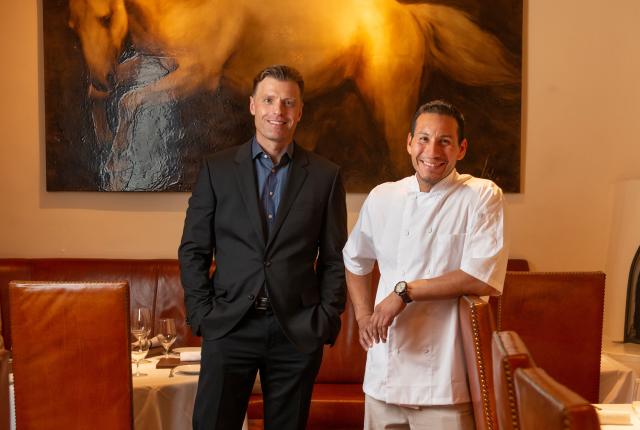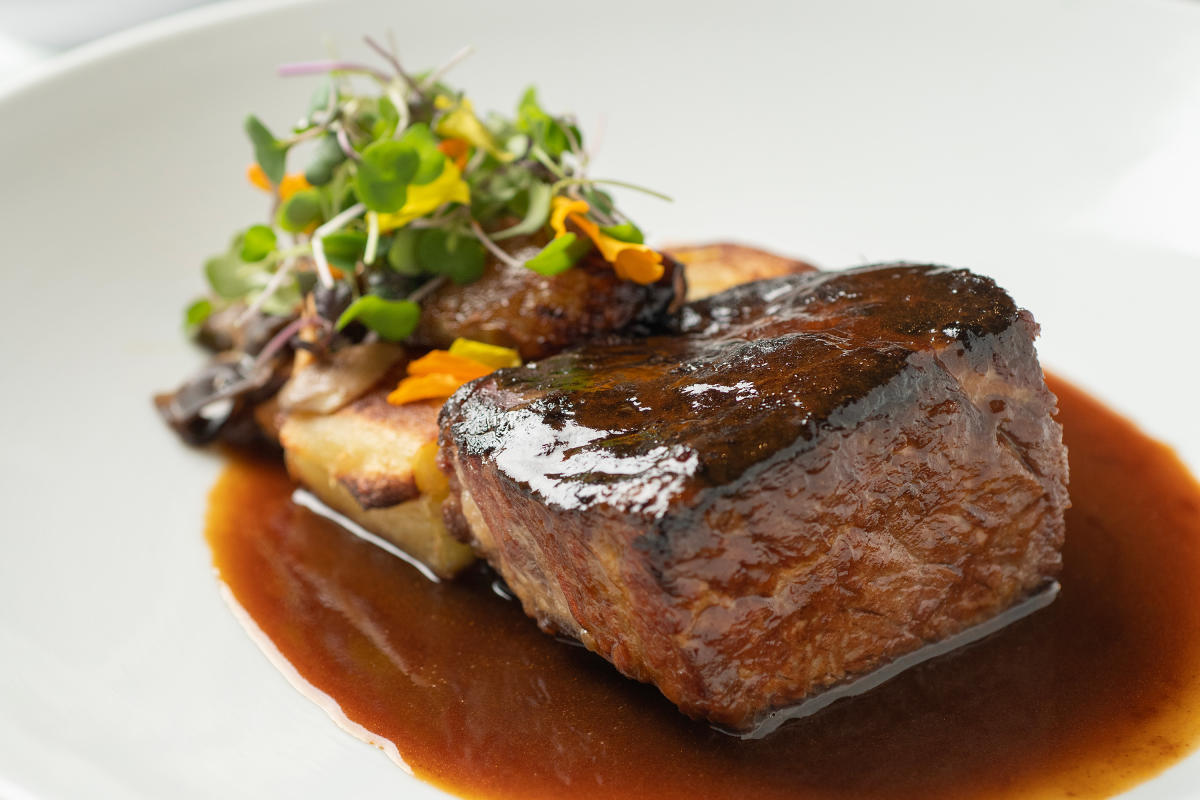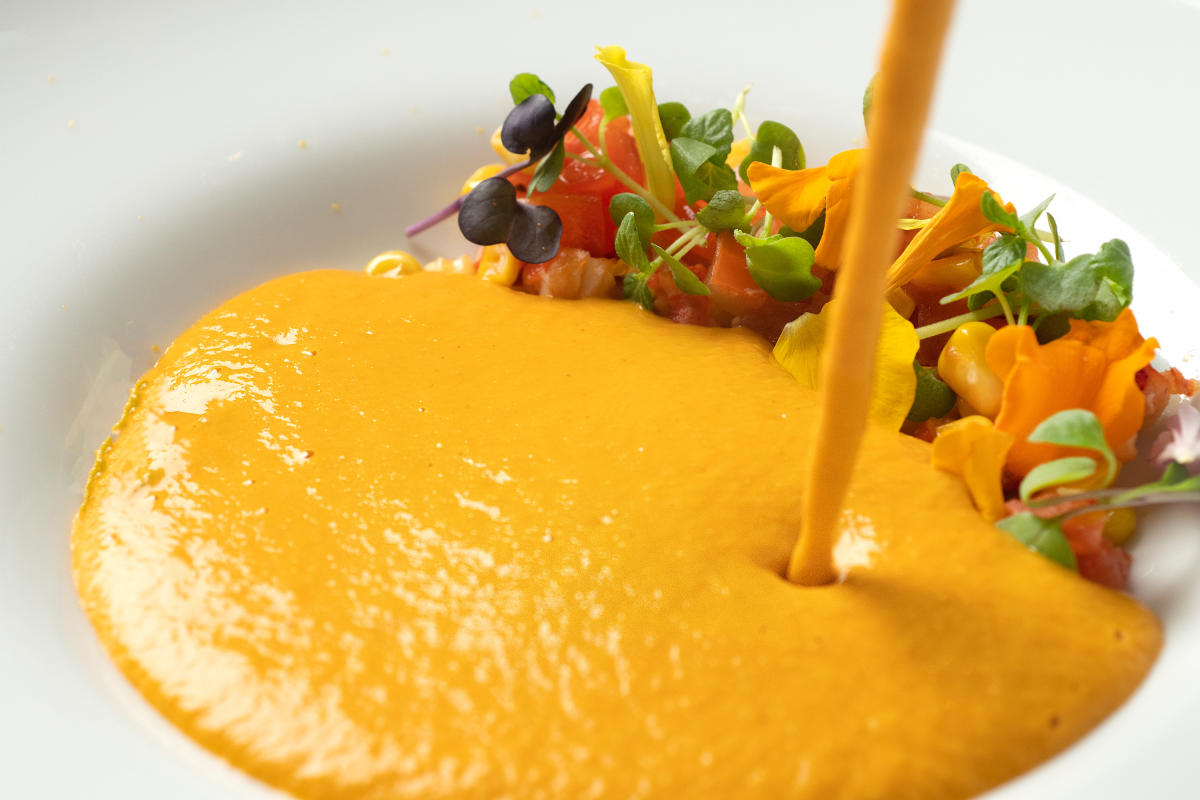SHOULD YOU ASK A PARENT which one of their offspring is their favorite, most would have a hard time answering. Ask a chef and food writer which restaurant is his or her favorite and the same challenge may be true. At least publicly. In the weekly classes at my cooking school, visitors and locals ask exactly that question, repeatedly. I love restaurants throughout our food-savvy state. But if you told me that you had only one night in Santa Fe to dine out, here’s where would I send you: Geronimo.
This fine-dining culinary institution on Canyon Road wins national awards, including AAA’s Four Diamond, Forbes Travel Guide Four Star, and OpenTable’s and Trip Advisor Travelers’ Choice’s Top 100 Restaurants. Since opening in 1991, Geronimo has weathered the often-bumpy road of the hospitality industry without losing steam. Chefs have come and gone, ownership has changed, food trends have morphed, and competition has threatened to knock the place out of popularity, but never has it exhibited a noticeable glitch.
I’ve probably dined there more than 100 times. I’ve celebrated birthdays, introduced visiting chefs to its wonders, written about it for numerous publications, and happily dropped a stockpot full of cash to enjoy the perfect mingling of food, decor, service, and wine. (Disclaimer: I didn’t always pay for meals, but, comped or not, I’m its biggest fan.)
From the Wagyu beef carpaccio appetizer to Green Miso Sea Bass, New Mexico Four Corners Grilled Rack of Lamb, and Geronimo’s famous Tellicherry Rubbed Elk Tenderloin, the dinner-only meals are exquisitely prepared and served.
Owners Chris Harvey and Sllin Cruz, who is also the chef, sat down with me recently to recap three decades of Geronimo history. Housed in a stately former residence built in 1756, the Borrego House, the restaurant bears an ageless design that includes adobe walls plastered in an eggshell color, complemented by burnt-caramel-tone seats and banquettes. A seat near one of the fireplaces is prime dining real estate on a chilly night.
“This building has been a variety of restaurants, including Three Cities of Spain in the 1960s and Alfonso’s in the late 1980s,” Harvey says. “Folks think our name originates with the historical figure of Geronimo, but in fact two Spaniards with that name have been previous owners of the building.”
Harvey started at Geronimo as a waiter, in 1992, detouring from his studies in production and operations management at New Mexico State University. “What I learned in that program has completely given me the tools I use in this business,” he says. “Our customers sign up for the whole experience of fine dining. Pulling together the elements of food, service, and wine takes planning and organization—just as engineering does.”
Cruz left the Mexican state of Michoacán when he was 13, first landing in Utah and spending more than 20 years in various positions at restaurants. He moved into the chef de cuisine post at Geronimo and worked under legendary chef Eric DiStefano for a year before DiStefano’s untimely death, in 2016. That year, Cruz began learning the magic and mastery of the Geronimo menu. He continues to move the culinary program forward with new dishes and creative specials that he calls “global eclectic.”
As we prepare to sample a delicious early dinner—timed to give both men a chance to kick into their roles later—memories of DiStefano bubble up. Eric was a close friend of mine who put his stamp on Geronimo starting in 1996, when then co-owner Cliff Skoglund discovered him in a small Santa Fe inn called Hacienda del Cerezo. He became Geronimo’s chef and, eventually, a partner at both Geronimo and the Coyote Café, along the way earning several nominations for a James Beard Award.
“Eric elevated the Santa Fe dining scene and raised the bar on what people thought fine dining was,” Harvey says. “His influence brought attention to Santa Fe.”
Maintaining the bar he set involves more than food. It takes people. “I think our entire staff are career professionals, not just servers and cooks,” Harvey says. “We want them to commit to being part of the team. Both Sllin and I agree giving a little extra in pay and taking care of staff is our primary goal.”
“I need my cooks to have good palates,” Cruz adds, “and to know the flavors they are looking to accomplish with their cooking.”
I regularly hear diners complimenting the consistency of Geronimo’s food—a testament to Cruz’s commitment to training his staff. Even the menu has held steady since Cruz took over the kitchen. “Sllin does change and add to the menu, about 40 percent seasonally,” Harvey says. “But we get guests who fly into town specially for the elk tenderloin, so some things will always be on the menu.” (Harvey and Cruz say their favorite dish is the 72-Hour Sous Vide Short Ribs.)
After enjoying that divine elk dish and its brandied mushroom sauce, and finishing dinner with a luscious Meyer lemon crepe, I can see the restaurant starting to fill up. I think how lucky each diner is, about to enjoy such a special experience. “Geronimo could last 100 years as an institution,” Harvey says before we part. “The pandemic was tricky. We closed for three months and briefly tried to offer takeout, but it just didn’t work well. I did spend the time tripling our wine inventory, and I feel Geronimo came back stronger than ever.”
Sous vide has long been used by restaurants to prepare and hold large batches of food and as a terrific way to tenderize proteins. Smaller, more affordable versions of the machines are available for home cooks, which has created a new generation of what I call Sous Vide Geeks, who are experimenting with all kinds of recipes. See chef Johnny Vee's note at the bottom of the recipe for an alternate cooking method.
RIBS
2 pounds beef chuck short ribs
1 teaspoon kosher salt
1 teaspoon black pepper
1 cup olive oil
1 shallot, peeled and sliced
1 sprig rosemary, de-stemmed and chopped
POTATOES
3 large Yukon gold potatoes
2 cups heavy cream
1 cup shredded Parmesan cheese
½ teaspoon salt
½ teaspoon pepper
ASSEMBLY
2 tablespoons truffle oil
2 cups demi-glace*
2 tablespoons olive oil
3 shallots, peeled
8 ounces mixed mushrooms (button, brown, shiitake), sliced thickly
Microgreens
Serves 3
RIBS
1. Season the ribs with salt and pepper. In a bowl, combine the shallots, olive oil, and rosemary. Add the short ribs, turning them in the marinade to coat. Cover and refrigerate for 2 hours.
2. Discard the marinade and place the short ribs in a vacuum pouch, then seal it. Preheat the water in a sous vide circulator to 60 degrees, place bag in water, and cook for 72 hours.
POTATOES
1. Preheat oven to 365°.
2. Using a mandoline, slice the potatoes ½ inch thick. Place the cream in a medium bowl. Stir in the Parmesan, salt, pepper, and potatoes. Stir to coat well.
3. Place the mixture in a 9-by-13-inch baking dish, cover with foil, and bake for 35 minutes or until a knife can be easily inserted into the potatoes. Uncover and bake for 15 more minutes to brown the top.
ASSEMBLY
1. Mix the truffle oil with the demi-glace in a small saucepan set on low heat.
2. Heat olive oil in a medium pan and add shallots and mushrooms. Sauté until the mushrooms start to brown and shallots are tender. Remove from heat and keep warm.
3. Remove the short ribs from the sous vide pouch and place on an ovenproof dish. Bake at 400° for 15 minutes; remove and slice the meat into 3 equal portions.
4. In a hot pan, sear the slices. Turn heat to medium high and continue cooking until the meat is warmed through, about 3 minutes.
5. Cut potatoes into 3-by-3-inch portions (reserve remaining potatoes for a future meal).
6. Place meat and potatoes on a heated plate and ladle warmed demi-glace over the beef. Top with sautéed mushrooms, shallots, and microgreens.
*Demi-glace is a rich reduction of beef and veal stock with vegetables that restaurants make and finish meat dishes with. Home cooks can find it in the soup section of the grocery store. Look for the More Than Gourmet Classic French Demi-Glace brand and dilute 1 part demi-glace concentrate to 4 parts water.
Note: If you don’t have a sous vide, don’t worry. I recommend this as an alternative: Sear the ribs in olive oil. Place in a Dutch oven and add ½ cup chopped onion, ½ cup chopped carrot, ½ cup chopped celery, ½ cup red wine, and ½ cup beef stock. Cover and braise in a 300° oven for 2–3 hours, or until fork tender.
Chef Sllin Cruz offers this gourmet version of everyone’s favorite soup, fancied up with lobster and fresh corn.
12 Roma tomatoes
3 tablespoons butter
1 cup diced celery
1 cup diced carrots
1 cup diced yellow onion
1 tablespoon chopped garlic
2 teaspoons tomato paste
6 cups chicken stock
½ cup fresh basil
4 cups heavy cream
Salt and pepper to taste
FOR GARNISH:
1 tablespoon butter
1 shallot, thinly sliced
3 ounces lobster meat, roughly chopped
1 cup sweet corn
Serves 6
1. Dry-roast the tomatoes in a hot pan without any oil for 7 minutes, turning occasionally, until the skin is nicely charred on all sides. Allow to cool, then peel and set aside.
2. In a large soup pot, melt butter over medium heat and then add celery, carrots, onions, and garlic. Sauté until vegetables are tender, about 10 minutes.
3. Chop the tomatoes and add to the pot with tomato paste, chicken stock, basil, and cream. Let simmer until tomatoes have completely softened, about 20 minutes.
4. Carefully puree soup in batches and season with salt and pepper.
5. For the garnish, melt butter in a medium pan and sauté shallot until it starts to sweat. Stir in lobster and corn and cook until warmed through. Serve a spoonful in each bowl of soup.






